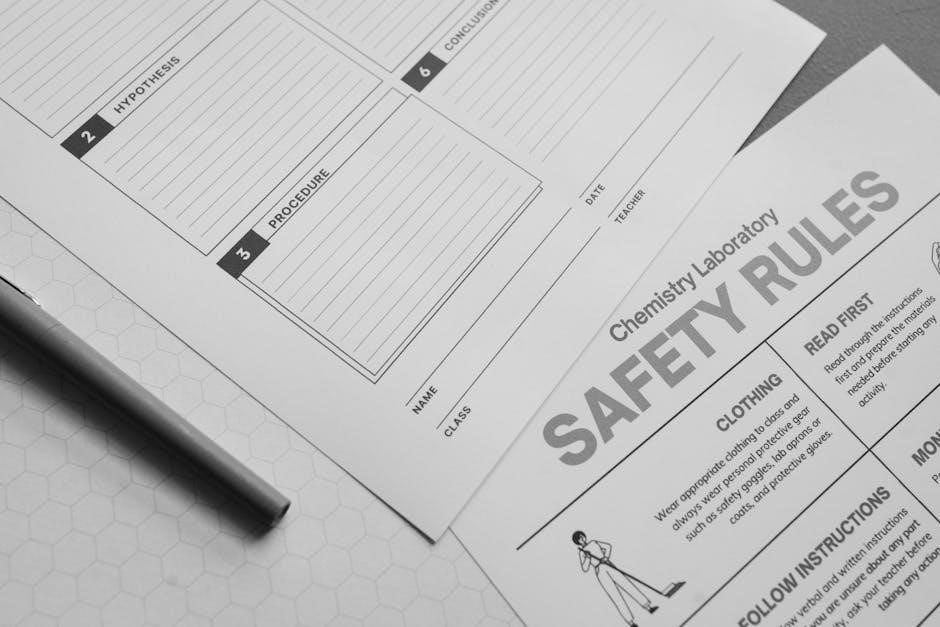Repatriation involves returning cultural, historical, or ancestral items to their rightful communities, ensuring ethical and legal compliance․ This guide provides a structured approach to planning, executing, and monitoring repatriation projects effectively, addressing key considerations and best practices․
Understanding the Basics of Repatriation
Repatriation refers to the process of returning cultural, historical, or ancestral items to their communities of origin․ It involves ethical, legal, and cultural considerations, ensuring respect for Indigenous rights and heritage․ Key principles include voluntary return, community consent, and adherence to local and international laws․ Repatriation projects often involve collaboration between museums, governments, and Indigenous groups․ Understanding the cultural significance of items is crucial, as is documenting their provenance․ Legal frameworks, such as the Native American Graves Protection and Repatriation Act (NAGPRA), guide these processes․ Repatriation also addresses historical injustices, fostering reconciliation and cultural preservation․ Effective planning requires research, stakeholder engagement, and transparent communication․ This foundational understanding is essential for developing successful repatriation initiatives that honor cultural heritage and promote justice․

The Importance of Repatriation in Cultural and Historical Contexts
Repatriation holds profound significance in preserving cultural identity and historical integrity․ Returning ancestral remains and artifacts restores heritage to their rightful communities, fostering cultural revitalization and reconciliation․ It addresses historical injustices, acknowledging past wrongs and promoting healing․ In cultural contexts, repatriation strengthens community ties, enabling education and traditions to thrive․ Historically, it corrects colonial legacies, ensuring artifacts are preserved within their cultural framework․ Legal frameworks like NAGPRA emphasize repatriation’s role in justice and equity․ Museums and institutions increasingly recognize the ethical imperative to return items, respecting Indigenous rights․ Repatriation also enhances global understanding, bridging cultural gaps․ By honoring origins, it ensures future generations can connect with their heritage․ Thus, repatriation is vital for cultural preservation, historical accuracy, and ethical accountability, benefiting both source communities and the global community․


Planning and Developing Repatriation Projects
Effective planning involves defining objectives, engaging stakeholders, and ensuring legal compliance․ Budgeting, resource allocation, and community collaboration are crucial for successful project development and implementation, ensuring ethical and culturally sensitive repatriation practices․
Setting Clear Objectives for Repatriation Initiatives
Setting clear objectives is essential for the success of repatriation projects․ These objectives should align with the cultural, historical, and legal contexts of the items or individuals being repatriated․ They must be specific, measurable, achievable, relevant, and time-bound (SMART)․ For instance, an objective might involve the return of ancestral remains to a specific Indigenous community within a defined timeline․ Objectives should also consider the needs and expectations of all stakeholders, including communities, museums, and legal entities․ It is important to ensure that these objectives are communicated clearly to all parties involved to avoid misunderstandings and ensure a unified approach․ Additionally, objectives should be flexible enough to adapt to challenges that may arise during the process․ By establishing well-defined goals, repatriation initiatives can be more effectively managed and their outcomes can be better evaluated․ This step is crucial for ensuring that repatriation efforts are both respectful and successful․
Legal Frameworks and Compliance in Repatriation Processes
Legal frameworks play a critical role in ensuring that repatriation processes are conducted ethically and lawfully․ Laws such as the Native American Graves Protection and Repatriation Act (NAGPRA) in the United States and international conventions like UNESCO’s 1970 Convention on the Means of Prohibiting and Preventing the Illicit Import, Export, and Transfer of Ownership of Cultural Property provide guidelines for repatriation․ Compliance with these frameworks is essential to avoid legal disputes and ensure the respectful return of cultural items․ Repatriation projects must adhere to national and international laws, which often require documentation, provenance research, and consent from rightful owners․ Legal experts and stakeholders must be involved to navigate complex jurisdictional issues, particularly in cross-border repatriations․ Compliance also involves respecting Indigenous laws, protocols, and cultural sensitivities․ By adhering to legal standards, repatriation initiatives can ensure transparency, accountability, and the preservation of cultural heritage for future generations․ Legal frameworks thus serve as the foundation for successful and ethical repatriation practices․
Budgeting and Funding Strategies for Repatriation Projects
Budgeting and securing funds are crucial for the success of repatriation projects․ Costs may include research, transportation, documentation, and community engagement․ Funding can come from government grants, private donations, or partnerships with organizations․ For instance, the National Lottery Project Grants and other institutional programs often support such initiatives․ A detailed budget should outline expenses, ensuring transparency and accountability․ It’s essential to allocate resources efficiently, prioritizing ethical practices and community needs․ Fundraising strategies may involve collaboration with museums, universities, or NGOs to pool resources․ Additionally, some repatriation programs offer financial assistance, like temporary loans or grants, to facilitate the process․ Proper financial planning helps mitigate risks and ensures the project’s sustainability․ By diversifying funding sources and maintaining rigorous budgetary controls, repatriation projects can achieve their objectives without compromising on quality or integrity․
Engaging Communities and Stakeholders in Repatriation Planning
Engaging communities and stakeholders is vital for the success and legitimacy of repatriation projects․ Active participation ensures that the needs and wishes of the affected communities are respected․ Collaboration with Indigenous leaders, local organizations, and cultural experts fosters trust and transparency․ Regular consultations and workshops can be organized to gather input and address concerns․ Stakeholder engagement should be inclusive, involving not only community members but also museums, governments, and NGOs․ Clear communication channels and accessible resources help maintain involvement throughout the process․ Additionally, incorporating traditional knowledge and protocols into planning ensures cultural sensitivity․ Partnerships with tribes and Indigenous groups, as seen in programs like the Indigenous Repatriation Program, demonstrate the importance of collaborative efforts․ By prioritizing community engagement, repatriation projects can achieve mutually beneficial outcomes, promoting healing and reconciliation while preserving cultural heritage for future generations․

Implementing Repatriation Projects
Repatriation projects require meticulous execution, focusing on logistical arrangements, documentation, and adherence to legal frameworks․ Step-by-step instructions ensure compliance, cultural sensitivity, and successful transfer of items to their rightful communities or countries․
Conducting Research and Due Diligence
Conducting thorough research and due diligence is critical in repatriation projects to ensure the correct identification and return of items․ This involves verifying provenance, consulting with communities, and reviewing legal requirements․ Proper documentation and collaboration with experts help maintain accuracy and trust․ By following established guidelines and engaging in transparent communication, the process respects cultural heritage and legal obligations, ensuring a successful repatriation outcome․
Logistical Arrangements for Repatriation
Logistical arrangements are essential for the smooth execution of repatriation projects․ This includes organizing transportation, storage, and handling of items, ensuring their safety and preservation․ Specialized packaging and climate-controlled storage may be required for sensitive or fragile items․ Additionally, securing funding and resources, such as trained personnel and equipment, is crucial․ Coordination with local authorities, communities, and cultural institutions is necessary to facilitate the process․ Permits, customs clearance, and compliance with international laws must also be addressed․ Documentation and tracking systems should be implemented to monitor the movement of items․ Engaging local experts and communities ensures cultural sensitivity and respect for traditional practices․ Contingency plans should be in place to address potential challenges, such as delays or unexpected damages․ By carefully planning and executing logistical arrangements, repatriation projects can be carried out efficiently and respectfully, ensuring the successful return of items to their rightful owners․
Documentation and Record-Keeping Best Practices
Effective documentation and record-keeping are critical components of successful repatriation projects․ Detailed records should be maintained for each item, including descriptions, provenance, and cultural significance․ Inventory lists, condition reports, and photographic documentation ensure transparency and accountability․ All documentation should be shared with relevant stakeholders, including communities of origin, to facilitate collaboration and trust․ Records must comply with legal and ethical standards, such as the Native American Graves Protection and Repatriation Act (NAGPRA), ensuring adherence to cultural and legal requirements․ Provenance research should be thoroughly documented to verify the origins and rights of ownership․ Secure storage solutions, both physical and digital, should be implemented to safeguard records and prevent loss․ Regular audits and updates to documentation are essential to maintain accuracy and reflect ongoing project developments․ By prioritizing robust documentation practices, repatriation efforts can ensure clarity, respect, and long-term preservation of cultural heritage․
Executing Repatriation: Step-by-Step Instructions
Executing a repatriation project involves a structured, step-by-step approach to ensure efficiency and respect for cultural and legal requirements․ Begin by initiating the repatriation process through formal notifications to stakeholders, including communities of origin and legal authorities․ Conduct a thorough inventory of items to be repatriated, verifying their cultural and historical significance․ Prepare items for transportation, adhering to conservation standards and cultural protocols․ Arrange secure and climate-controlled transportation, ensuring compliance with international and local laws․ Upon arrival, facilitate a formal handover ceremony, involving community leaders and stakeholders to honor the return of items․ Document the entire process, including pre- and post-repatriation activities, and maintain detailed records for transparency․ Finally, provide a report to all parties involved, detailing the outcomes and ensuring accountability․ Post-repatriation, engage with communities to support the reintroduction of items into their cultural context, fostering education and preservation efforts․

Monitoring and Evaluating Repatriation Projects
Monitoring and evaluating repatriation projects ensures accountability, measures success, and identifies areas for improvement․ Regular audits, stakeholder feedback, and performance metrics help assess compliance, cultural impact, and long-term sustainability of repatriation efforts․
Establishing Metrics for Success in Repatriation

Metrics for success in repatriation projects are essential to measure progress, accountability, and impact․ Key performance indicators (KPIs) include the number of items repatriated, timeliness of returns, and compliance with legal frameworks․ Stakeholder satisfaction, such as feedback from Indigenous communities, is also critical․ Metrics should assess cultural preservation outcomes, educational initiatives, and community engagement levels․ Additionally, financial efficiency and adherence to budget constraints are important factors․ Regular reporting and transparency ensure that objectives are met and challenges are addressed promptly․ By establishing clear, measurable goals, repatriation projects can demonstrate their effectiveness and contribute to broader cultural and historical preservation efforts․
Conducting Regular Project Audits and Assessments
Regular audits and assessments are crucial for ensuring the integrity and effectiveness of repatriation projects․ These processes involve evaluating compliance with legal frameworks, budget adherence, and the accuracy of documentation․ Audits help identify potential discrepancies or inefficiencies, allowing for timely corrections․ Assessments also focus on the ethical treatment of repatriated items, ensuring respect for cultural and historical significance․ By conducting these evaluations, project managers can verify that all stakeholders, including communities and institutions, are satisfied with the process․ Additionally, audits provide transparency, fostering trust and accountability among all parties involved․ Regular assessments ensure that repatriation projects align with their intended goals and uphold the highest standards of professionalism and cultural sensitivity․ This systematic approach not only strengthens the credibility of the project but also contributes to the preservation of cultural heritage for future generations․
Addressing Challenges and Adapting Strategies
Repatriation projects often encounter challenges such as legal complexities, funding shortages, or resistance from stakeholders․ To address these issues, it is essential to develop flexible strategies that adapt to changing circumstances․ Collaborating with legal experts, for instance, can help navigate intricate frameworks, while engaging communities ensures their concerns are addressed․ Budgetary constraints can be mitigated by exploring alternative funding sources or reallocating resources․ Additionally, fostering open communication among stakeholders can build trust and resolve conflicts․ Continuous monitoring of project progress allows for timely adjustments to strategies․ By remaining proactive and responsive, project teams can overcome obstacles and ensure the successful execution of repatriation initiatives․ Adapting strategies not only enhances the efficiency of the process but also strengthens relationships with involved parties, ultimately contributing to the ethical and culturally sensitive return of items or individuals․ This adaptive approach is critical for achieving long-term success in repatriation efforts․

Post-Repatriation Support and Reintegration
Post-repatriation support ensures the successful reintegration of repatriated items or individuals into their communities․ This phase involves ongoing assistance, cultural preservation efforts, and fostering long-term partnerships to sustain the impact of repatriation initiatives․
Providing Ongoing Support to Repatriated Individuals or Items
Providing ongoing support is crucial for ensuring the well-being of repatriated individuals or the preservation of items․ This involves continuous assistance, such as cultural reintegration programs, psychological support, and community engagement․ For items, it includes proper conservation techniques, storage solutions, and educational initiatives to maintain their historical significance․ Regular monitoring and evaluation of these efforts help in addressing any emerging challenges․ Collaboration with local communities and experts is essential to tailor support programs according to specific needs․ Additionally, documentation and knowledge sharing ensure that the repatriation process and its outcomes are transparent and accessible for future reference․ By fostering a supportive environment, repatriation efforts can achieve their full potential in restoring cultural heritage and promoting social cohesion․
Fostering Cultural Preservation and Education
Fostering cultural preservation and education is a cornerstone of successful repatriation projects․ By integrating educational programs, communities can gain a deeper understanding of their heritage, ensuring its continued relevance․ Collaborative efforts with schools, museums, and cultural organizations help disseminate knowledge widely․ Workshops, exhibitions, and digital platforms are effective tools for sharing the significance of repatriated items․ Additionally, training programs for local custodians and educators enhance their ability to preserve and interpret cultural artifacts․ Public awareness campaigns further promote the importance of repatriation, fostering a sense of ownership and responsibility․ These initiatives not only preserve cultural heritage but also empower future generations to value and protect it․ By embedding education into repatriation processes, the cultural identity and historical legacy of communities are safeguarded for years to come․
Building Long-Term Partnerships for Sustained Impact
Building long-term partnerships is essential for the sustainable success of repatriation projects․ Collaborative efforts between museums, Indigenous communities, and cultural organizations foster mutual respect and trust․ These partnerships ensure that repatriation processes align with the needs and values of the communities involved․ By engaging in joint initiatives, such as cultural preservation programs and educational projects, stakeholders can create lasting legacies․ Partnerships also facilitate resource sharing, expertise exchange, and collective problem-solving․ Regular communication and transparent decision-making strengthen these relationships, ensuring that repatriation efforts remain inclusive and impactful․ Additionally, partnerships can lead to grant opportunities, collaborative research, and community-driven initiatives, further solidifying the project’s long-term benefits․ Ultimately, these alliances not only enhance the repatriation process but also contribute to the broader goals of cultural preservation and reconciliation, ensuring a lasting and positive impact for future generations․

Lessons Learned and Best Practices
Repatriation success relies on collaboration, transparency, and adherence to Indigenous protocols․ Thorough documentation and continuous improvement ensure ethical and effective outcomes, fostering trust and long-term partnerships with communities․
Documenting Success Stories and Case Studies
Documenting repatriation success stories and case studies is crucial for sharing knowledge and fostering collaboration․ By capturing the outcomes of repatriation projects, organizations can highlight best practices, challenges, and lessons learned․ This documentation serves as a valuable resource for future projects, ensuring that the experiences gained are not lost․ Case studies provide detailed insights into the processes, strategies, and results of repatriation initiatives, allowing others to learn from both successes and setbacks․ Additionally, these records help in establishing a repository of proven methods and innovative approaches, which can be adapted to suit various contexts․ Effective documentation also aids in raising awareness about the importance of repatriation and its impact on communities, thereby promoting cultural preservation and reconciliation․ Ultimately, well-documented success stories and case studies contribute to the continuous improvement of repatriation practices worldwide․
Sharing Knowledge Across Organizations and Communities
Sharing knowledge across organizations and communities is essential for fostering collaboration and improving repatriation practices․ By exchanging insights, resources, and experiences, stakeholders can develop standardized approaches and address common challenges․ Organizations like museums, cultural institutions, and government agencies play a key role in facilitating this exchange․ For instance, the UNHCR provides guidelines and handbooks to help staff plan and implement repatriation projects effectively․ Similarly, initiatives such as the Indigenous Repatriation Program share knowledge on returning ancestral remains and cultural items․ Workshops, webinars, and collaborative platforms further enable the dissemination of best practices․ Sharing knowledge also promotes mutual understanding and respect among diverse communities, ensuring that repatriation processes are culturally sensitive and inclusive․ Ultimately, this collective effort enhances the efficiency and success of repatriation efforts, contributing to the preservation of cultural heritage and the restoration of dignity to affected communities․

Continuously Improving Repatriation Practices
Continuously improving repatriation practices ensures that processes remain effective, ethical, and aligned with the needs of communities․ Organizations should regularly review and refine their strategies based on lessons learned from past projects․ This involves documenting successes and challenges, as well as incorporating feedback from stakeholders, including communities, researchers, and legal experts․ By staying updated on evolving legal frameworks and cultural sensitivities, repatriation practices can become more inclusive and respectful․ Collaboration across organizations and industries fosters the sharing of best practices, while investing in training and capacity-building ensures that teams are well-equipped to handle complex cases․ Additionally, leveraging technology, such as digital databases and tracking systems, can enhance transparency and efficiency․ Continuous improvement also involves adapting to new information and evidence, ensuring that repatriation efforts remain grounded in justice and equity․ By prioritizing ongoing learning and adaptation, repatriation initiatives can achieve long-term success and lasting impact for affected communities․
